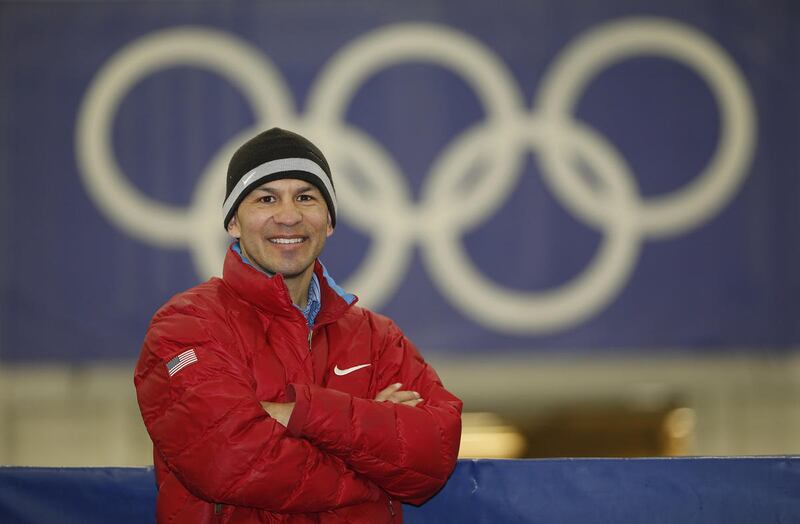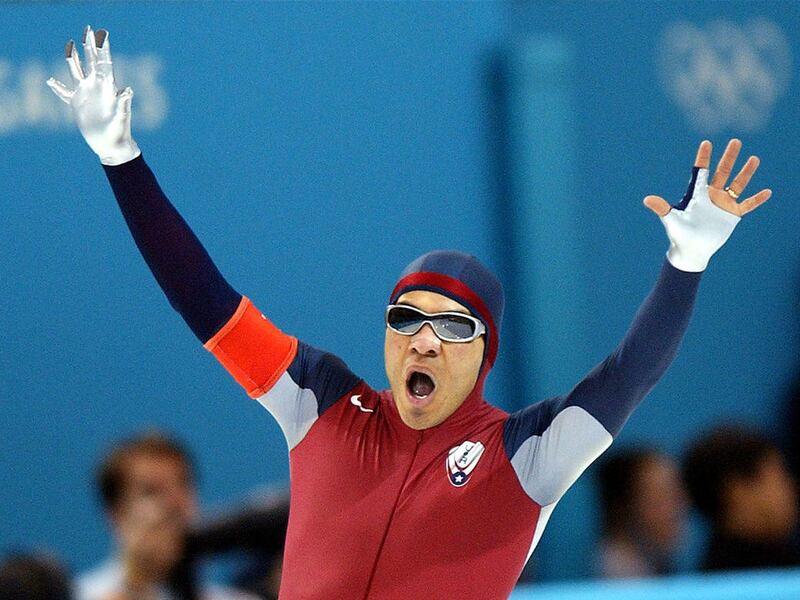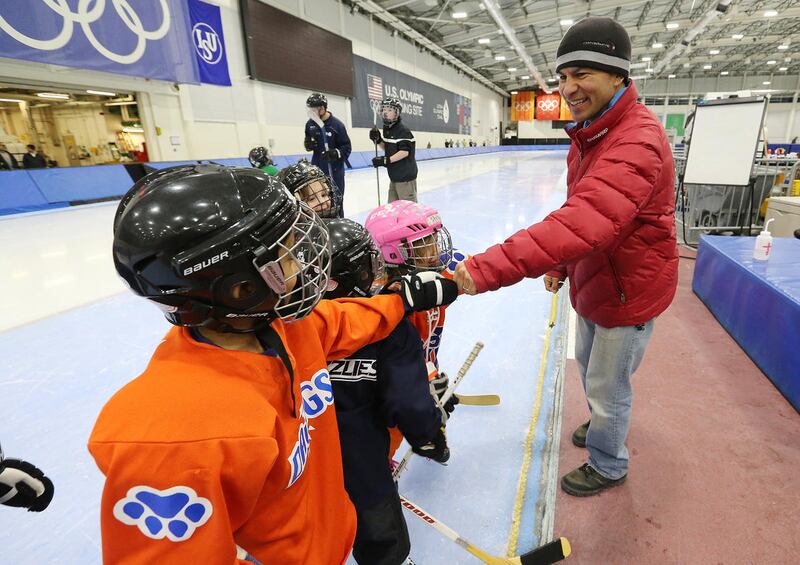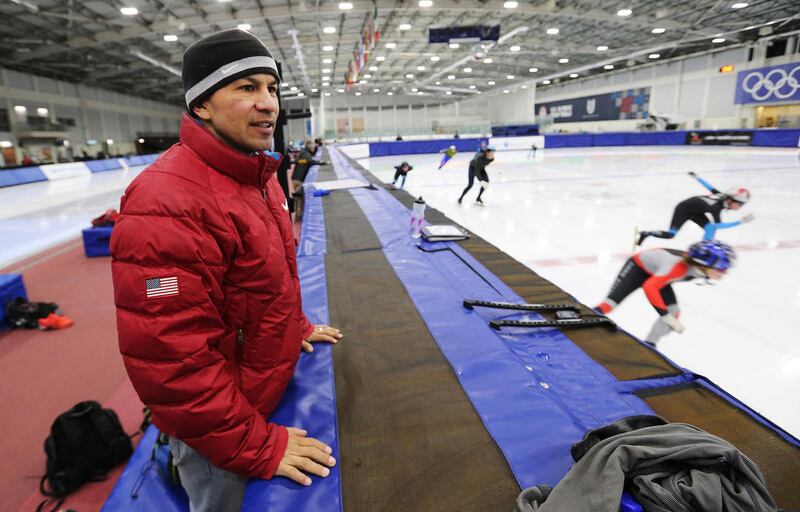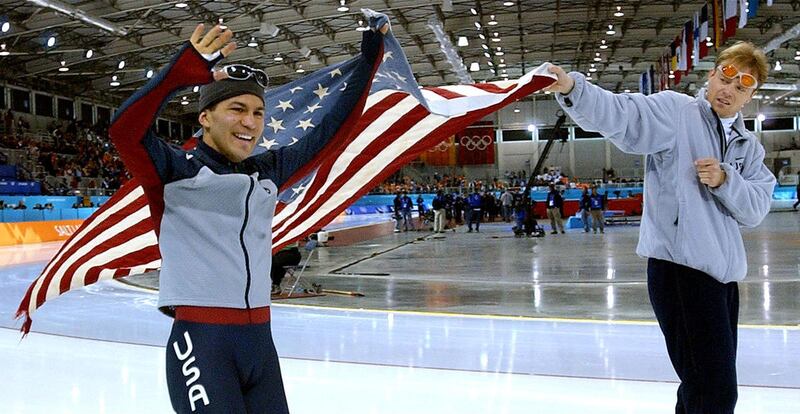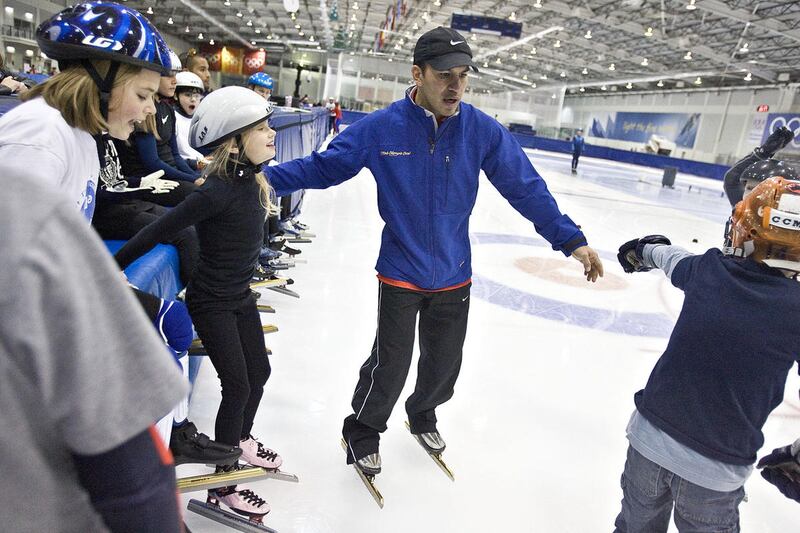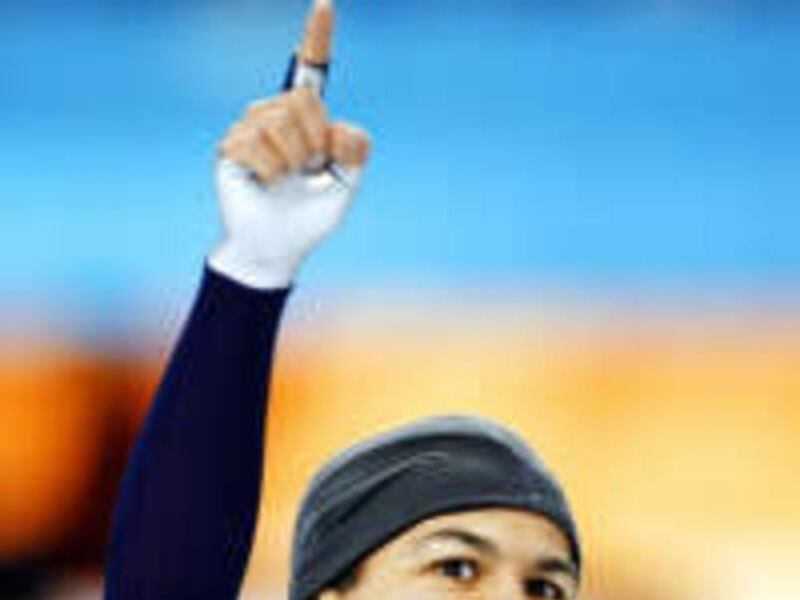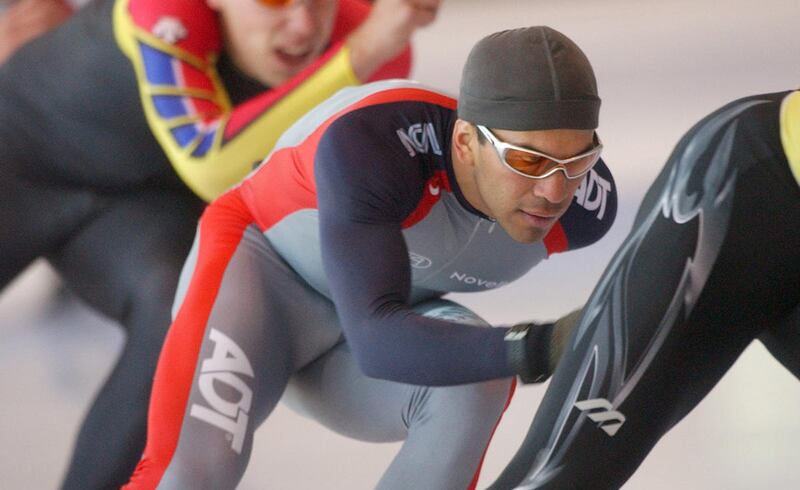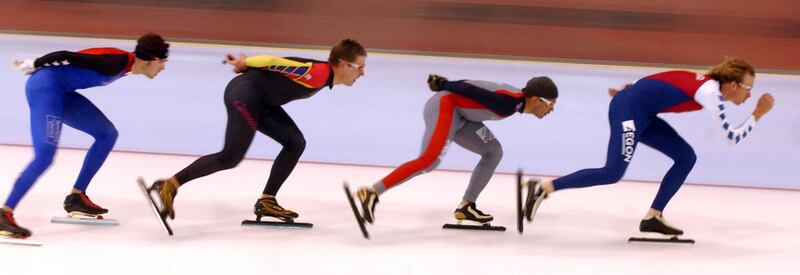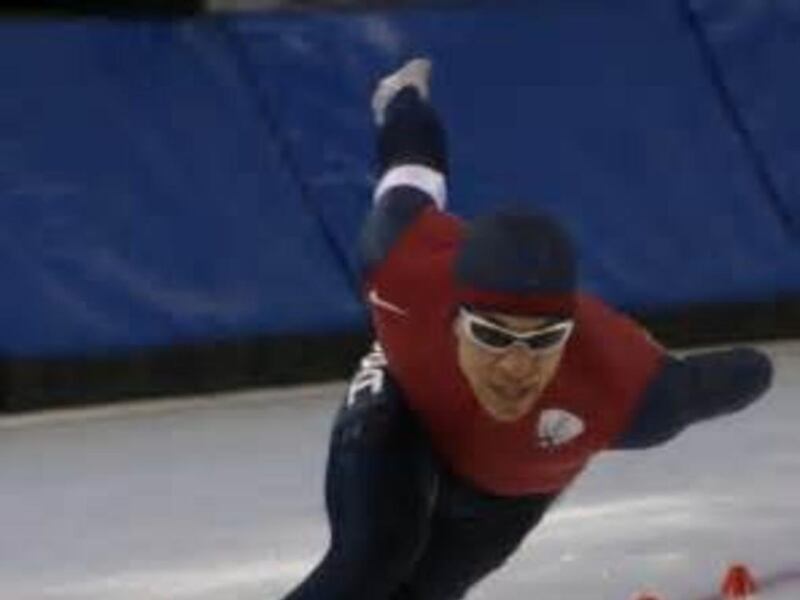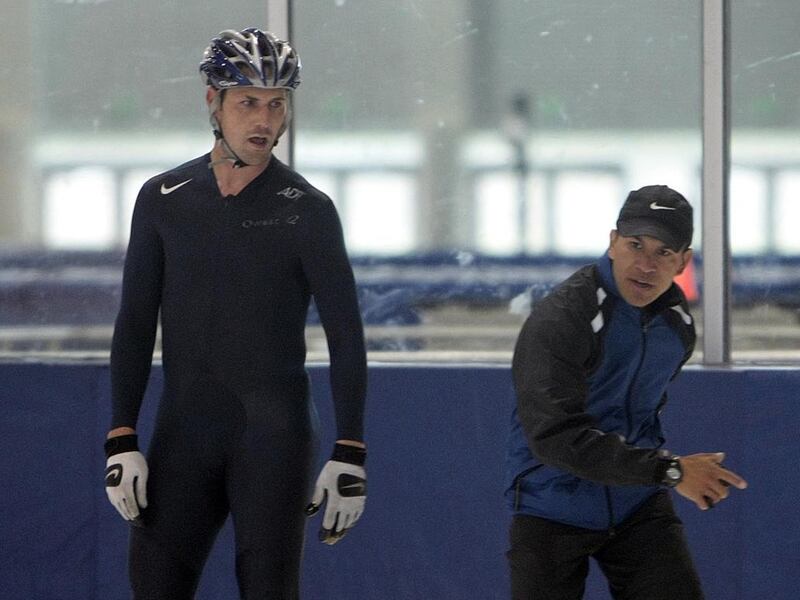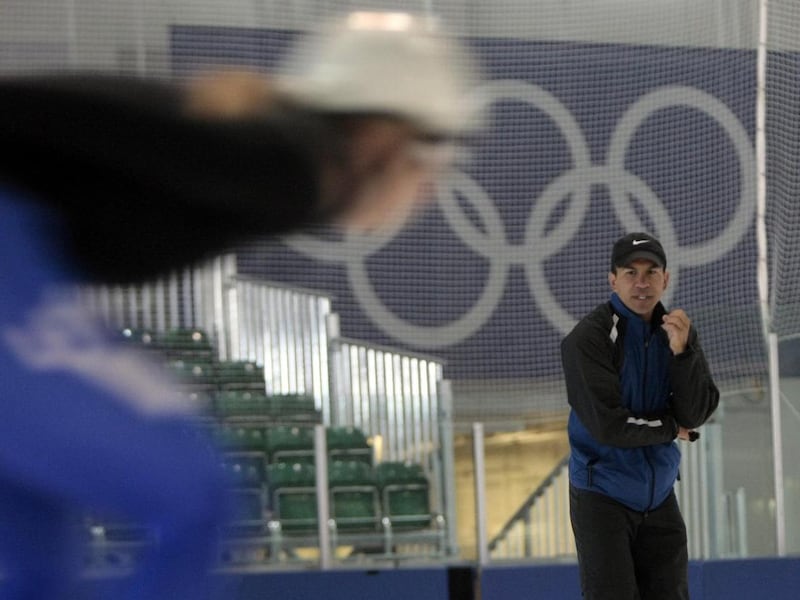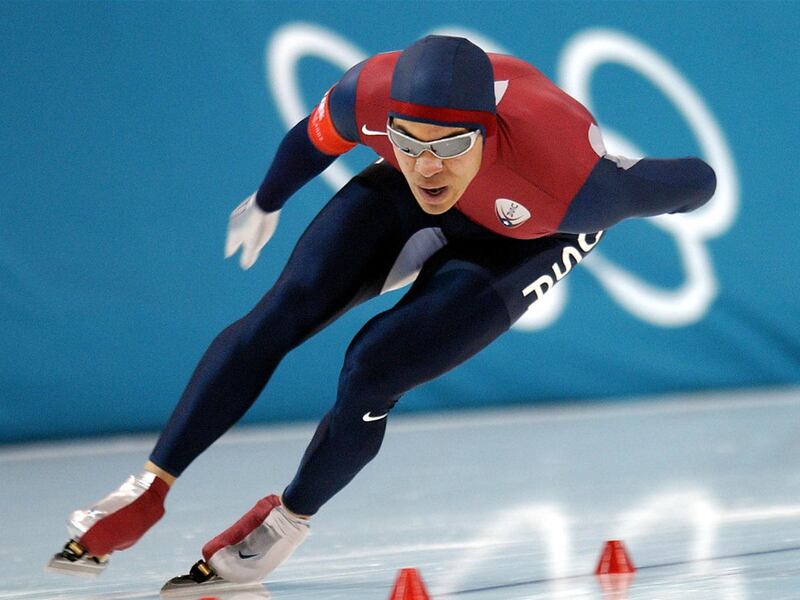Nobody wins in divorce; I wouldn’t wish it on my worst enemy. – Derek Parra
KEARNS — You can find Derek Parra most days at the Utah Olympic Oval, where he oversees a variety of winter sports and mingles daily with the public. He is still recognized for those few minutes on the ice 15 years ago. Hey, aren’t you that Olympic skater …? Parra, whose official title is director of sports, is employed by the very arena where he became an Olympic champion and one of the big stars of the 2002 Salt Lake Winter Games.
“I used to think about that when I was still skating, and once in a while I still do,” he says.
Each day he walks past a giant banner that hangs from a tower near the front door. It shows a larger-than-life photo of Parra shortly after his Olympic victory, holding a flag aloft.
Parra, you might recall, won the silver medal in the 5,000-meter race — a distance at which he had never finished in the top 10 — and days later won gold and set a world record in the 1,500.
He is 46 now and has been retired since 2006. Following the games, he took the modern-day victory lap. You know the drill: wrote a book, accepted an invitation to the White House, yucked it up with Letterman and Leno, went to the ESPYs and Oscars, rubbed shoulders with the Hollywood crowd (Heidi Klum and Kevin Spacey were kind and considerate; Oprah, not so much), signed up for several endorsements and TV commercials and became a regular on the speaking circuit. He still gives 20-30 motivational speeches a year around the country for various companies.
“When I left home at 17, I had no idea what was in store for me in my life,” he says. “That I would visit the White House and serve on the president’s council for physical fitness, that I would go to the Oscars and ESPYs. It’s crazy. Crazy!”
The Olympic medals and the money and fame came with a big price. He and his wife Tiffany divorced three years after the games. The long separations, the long hours he spent training and traveling, created tension and a divide. She lived with her parents in Florida and was pregnant while he trained in Utah for the 2002 Games. She gave birth to their daughter Mia two months before the Olympics. Tiffany watched Parra’s silver-medal race on TV, but dipped into savings to fly to Salt Lake to watch the second race in the Oval.
He retired from skating, but a sponsor lured him back to the sport. She urged him to continue his skating career for four more years now that he was finally earning money from it. Tiffany moved to Salt Lake City a few months later, but in the fall he was off again to race abroad and she returned to Florida. She returned again the following year with the same results. They decided to live apart again so he could train. By the time Parra arrived at the 2006 Torino Games in Turin, Italy, the marriage was being dissolved and he was distraught. He lost 10 pounds and took meds to sleep. The results in the 2006 Games were predictable: 19th in the 1,500. He retired from the sport and a few months later began working at the Oval.
“Nobody wins in divorce; I wouldn’t wish it on my worst enemy,” says Parra, who is engaged to marry again.
Perhaps nobody gambled more on the Olympics than Parra. His story has been told and retold. Raised by a single father in California, he took up the sport of rollerblading at 14, racing for hot dogs and Cokes. He left home at 17 to live and train with his coach in Florida and devote himself full-time to the sport. He went on to win 18 world titles in inline skating and earned a decent income from it — an estimated $50,000 annually — but there was one thing it couldn’t give him: an Olympic medal (inline skating is not an Olympic sport). In 1996, he gave up skating on land to take up skating on ice to pursue an Olympic berth. He had been on ice skates once in his life.
Two weeks after moving to Florida, he ran out of money. He worked at McDonald’s but didn’t have enough for living and training expenses. While working at the fast-food restaurant he noticed that company policy required employees to throw Egg McMuffins in the trash if they weren’t bought within 10 minutes. He volunteered to take out the trash and ate the sandwiches, and this became a source of daily meals.
Three weeks after switching to the ice, Parra won two bronze medals at the national championships in the 5K and 10K. He faced big disadvantages — his skating technique was understandably rough, and he was just 5 foot 4 in a sport dominated by the tall and long-limbed.
He compensated with the fitness he developed on inline skates and eventually developed a skating stroke that was as long as his tall rivals.
Parra earned a berth on the 1998 Olympic team, but at the last moment he was bumped from the competition (long story). Four years later he made his triumphant return to the Olympics in Salt Lake, but he very nearly quit the sport before he ever got there.
Five months before the Olympics he flew to Florida to visit his wife. The next day the jets struck the twin towers in New York. “It hit me hard,” Parra says. “I had put so much value in my sport literally going around in circles. Then I saw those images of the towers. I was embarrassed to be a speed skater. I lived in a bubble. I felt like an idiot. I was too focused on skating.”
When he returned to Utah he told coaches, sponsors and teammates he was done. His coach lured him back to daily practices while he sorted through things, but his heart wasn’t in it. He was sent to a sports psychologist.
“I decided to skate again, but for the victims,” he says. “That’s what I told myself. If I could give those families a few minutes to think about something else … I never talked about medals.”
The night before the opening ceremony he received a call from a USOC official asking him to be one of the eight athletes who would carry the tattered and torn World Trade Center flag into the opening ceremonies. Some team officials tried to talk him out of it because it would require him to be on his feet for several hours in the cold the night before his first race, but Parra was undeterred.
The eight athletes gathered outside the stadium to receive the flag. “We all instinctively touched the flag,” says Parra. “We were all rubbing it. It was as if my soul was being touched. It was powerful. We never said a word from that moment on. When we walked into the stadium (with the flag), we expected a cheer, but it was absolutely silent. During the national anthem a gust of wind almost blew it out of our hands. It was the breath of those victims. That’s all I could think. I started crying. No one said anything as we folded the flag afterward. I slept that night with a peace in my heart I have never known. I raced the next day. Everywhere I skated there was this warm pocket of air and skating was effortless. I felt very light. I skated 15 seconds faster than I had ever skated in my life.”
Ask him about his favorite moment from the Salt Lake Games, Parra hesitates, but only because he has to gather his emotions, even 15 years later. “Carrying the flag into the stadium; that defined my Olympics — my life, really,” he says.
Parra no longer skates on the track, although he works around it every day. His skating is limited to playing in an adult hockey league. But the memories of those games are everywhere in the building on the days when he will indulge them.
“The Salt Lake Olympics were a magical time, not just for me but many others,” he says. “The U.S. was trying to bounce back from September 11 and Americans won more medals than ever. It was a critical time for the country. It was somewhat motivational for the country, and that flag we carried stood for hope.”
Email: drob@deseretnews.com

